An open-source, multi-parameter, full fledged human body vital sign monitoring HAT for Raspberry Pi as well as standalone use.
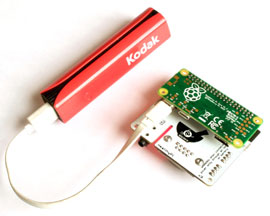 HealthyPi is the first fully open-source, full-featured vital sign monitor. Using the Raspberry Pi as its computing and display platform, the HealthyPi add-on HAT turns the Raspberry Pi into a vital sign monitoring system.
HealthyPi is the first fully open-source, full-featured vital sign monitor. Using the Raspberry Pi as its computing and display platform, the HealthyPi add-on HAT turns the Raspberry Pi into a vital sign monitoring system.
Who Needs the HealthyPi?
- If you are a student or researcher interested in incorporating human vital signs into your project, HealthyPi is easy to include in your research.
- For regions of the world where medical care is limited and the cost of a conventional patient monitor is prohibitive, a simple patient monitoring system could mean saving a life. HealthyPi can work as that patient monitor.
- If you are a medical device designer, HealthyPi is a useful prototyping device. If you like the results of a given prototype, you can simply take the module you developed (hardware and software files) and integrate it into your system with minimal guesswork.
- Recording and streaming data from standard patient monitors is far from “standard” and in most cases requires proprietary software. HealthyPi uses open-source software which provides an easier off-the-shelf interface to your data. Better still, you can build your own custom functionality right into the software.
Technical Specifications
- ECG and respiration front-End: Uses the TI ADS1292R 24-bit analog front-end with SNR of 107 dB
- Pulse oximetry: Uses TI AFE4490 Pulse Oximetry front-end with integrated LED driver and 22-bit ADC
- Temperature: Uses Maxim MAX30205 digital body temperature sensor for skin temperature sensing
- Main microcontroller: Atmel ATSAMD21 ARM Cortex M0 – compatible with Arduino Zero
- Programmability: Arduino Zero Bootloader preloaded
- Interfaces: Raspberry Pi 40-pin header (UART pins connected), USB CDC device, extra UART connector provided for connecting an external blood pressure module
- IoT functionality: Can use the Raspberry Pi’s Wi-Fi interface to communicate with a TCP client for telemedicine applications or using an MQTT client for continuous logging applications
- GUI Compatibility: Uses processing Java-mode (compiles on MacOS/Windows/Linux/Linux-ARM platforms)
- Firmware compatibility: Compiles with Arduino or Atmel Studio
- Dimensions (board only): 65 mm x 56.5 mm x 6 mm
- Weight: 100 g
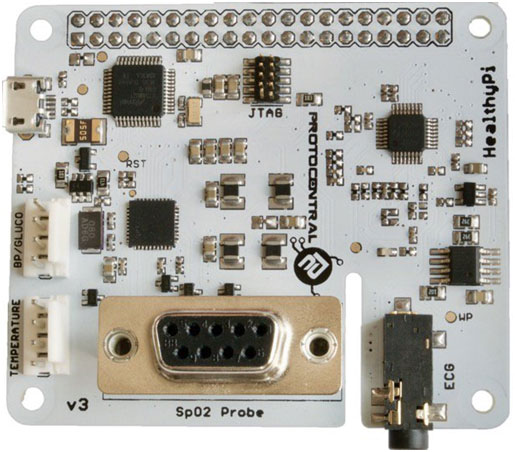 Feature Highlights
Feature Highlights
Easy-to-use
The simple, highly integrated design of the HealthyPi results in ease of manufacturing, more reliability, and lower cost. Nonetheless, some of the analog chips used here are the same ones present in professional patient monitoring systems.
We have ensured that the entire system is easy to use, makes it easy to add features, easy to customize, and easy to reproduce too, if you wish. The PCB design itself is simple and the software design is simpler.
You can get as deep into the technical details of the HealthyPi as you want. Just want to use it as a data monitor? Perform the default install and you’re ready to start using it right away. Are you a serious software hacker trying to make the software more efficient and the algorithms more intelligent? You can do that too.
Flexible
The HealthyPi was designed with not just one application in mind, but a variety of them. While it does function as a vital sign monitor for traditional patient monitoring applications, it can also be used for several other applications. You can use it with a Raspberry Pi using a display; use it with a Raspberry Pi with the official touchscreen using our “Complete Kit,” or you can use it standalone by connecting it to any computer’s USB port. The software is compatible across all platforms.
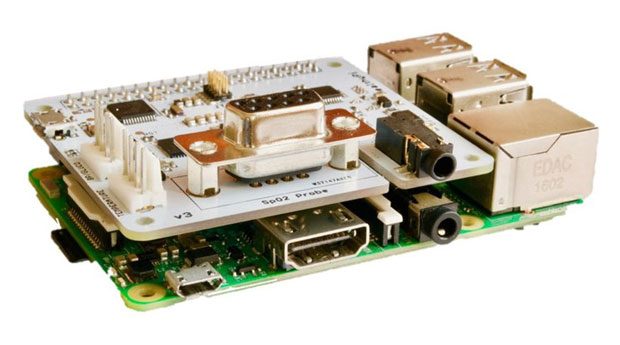 Ready for the Internet of Things
Ready for the Internet of Things
Utilizing the Raspberry Pi 3’s built-in WiFi and Bluetooth capability, the HealthyPi is ready to connect to the internet of things. This makes it very easy to get data into the cloud for any kind of analysis and/or decision-making. The built-in MQTT client in the processing GUI can send realtime vital signs data to any MQTT client/server with minimum overhead. Below is a screen-cap of the HealthyPi 3 sending data to an AWS EC2 instance running Thingsboard IoT platform.
 Open Source Hardware
Open Source Hardware
All the hardware schematics, layout, and BOM will be available on our Github repo soon after the campaign ends. This means you can modify, improve, and/or generally just hack the hardware. The hardware designs are all in Eagle, which makes it easily accessible and editable without spending a lot on expensive PCB design software. Also, unlike certain open source hardware, we don’t just give you the schematic, but the Eagle schematic, layout files and BOM. We make it easier for you to take our design and use it for your own.
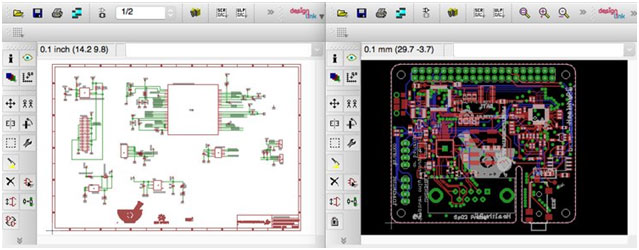 Open Source Firmware
Open Source Firmware
At the heart of the HealthyPi is the Atmel/Microchip ATSAMD21 microcontroller with an ARM Cortex M0 core. This is the same chip in the Arduino M0/Zero, which makes it automatically programmable with Arduino. You wrote a better algorithm for noise removal? Just edit the code to include the new program and upload it using the on-board USB port. If you want to skip using Arduino totally and just program the on-board processor directly with a JTAG programmer, there is also a JTAG header available. We will have the code for Atmel Studio 7 also.
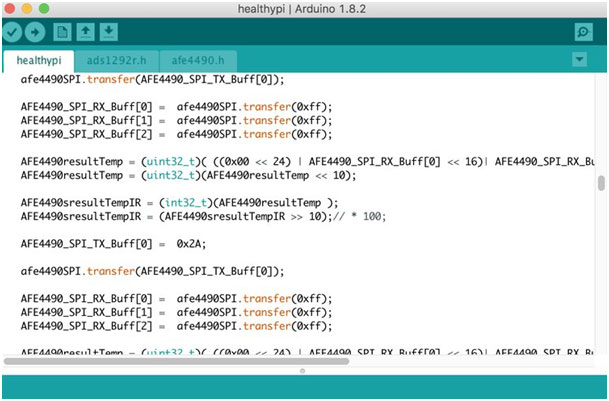 Open Source GUI Software
Open Source GUI Software
Processing is a great piece of open-source software that allows you to create any kind of desktop application with Java code. Processing itself is open-source and also has several user-contributed libraries. The software is platform agnostic and works equally well on Windows/MacOS/Linux and, of course, Linux-ARM, which is on the Raspberry Pi.
 What’s Included and What’s Required
What’s Included and What’s Required
Healthy Pi 3 HAT Kit includes:
- HealthyPi v3 PCB
- Three-electrode cable with “button” connectors on one end and stereo connector on the other end
- Finger-clip Spo2 probe with “Nellcor-compatible” DB9 connector
- Cable-mounted digital skin temperature sensor with stainless steel contacts.
- A sheet of 20 Single-use disposable ECG electrodes (Covidien Medi-Trace)
- HAT mounting kit with headers and screws for stacking up the board with a Raspberry Pi
Healthy Pi 3 Complete Kit includes:
- HealthyPi v3 PCB
- Three-electrode cable with “button” connectors on one end and stereo connector on the other end
- Finger-clip Spo2 probe with “Nellcor-compatible” DB9 connector
- Cable-mounted digital skin temperature sensor with stainless steel contacts.
- A sheet of 20 Single-use disposable ECG electrodes (Covidien Medi-Trace)
- HAT mounting kit with headers and screws for stacking up the board with a Raspberry Pi
- Raspberry Pi 3 board
- 16GB microSD card with pre-loaded Raspbian and Healthy Pi software
- Raspberry Pi official 7” touchscreen LCD displayed
- SmartiPi Touch enclosure for display and Pi
- 5 V/2.5 A isolated medical-grade USB wall power adapter (100-240 V AC). Snap-on plug according to destination country will be included.
If you wish to make changes to the Raspberry Pi code or connect the Raspberry Pi to your Wi-Fi network or anything else, you will need a keyboard and mouse which plugs into the Raspberry Pi. Touchscreen includes an on-screen keyboard also. If you wish to power your HealthyPi from a battery, you can use any standard USB power bank (NOT included) to power the system. We actually recommend the use of a power bank for providing power as it is safer and minimizes noise.
Manufacturing Plan
We have our own assembly and testing facility for low volume (100 pcs) production. This includes a small pick-and-place machine, ovens, and microscope inspection equipment. We also have our own team with testing and inspection expertise at our office/assembly facility/warehouse in Bangalore, India.
All the components for this products are from authorized, well-known vendors, primarily Digi-Key and Texas Instruments. This includes even smaller components such as capacitors and resistors to ensure we get consistent signal quality and reproducibility of signals each time, every time.
We have already successfully manufactured and sold hundreds of HealthyPi v2 boards to customers all over the world. So, we are in the know about manufacturing challenges and system performance and can plan appropriately. HealthyPi v3 is a huge overhaul of our earlier versions and is more stable. We are already all set for the manufacturing run for the first 100 units.












